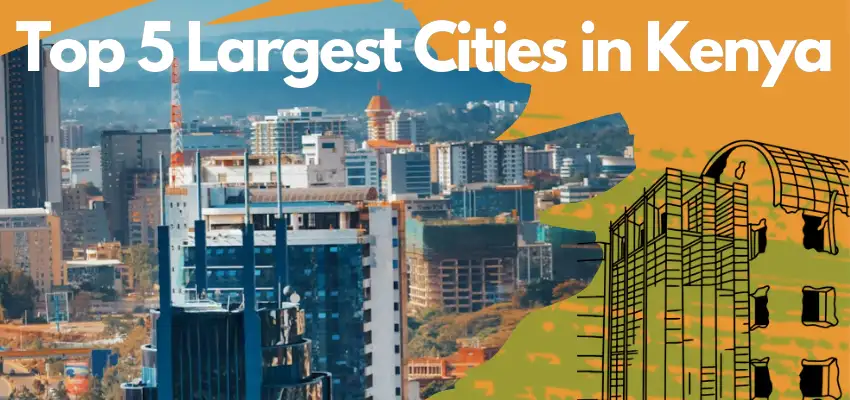African Travel and Tourism
Top 5 Largest Cities in Kenya
In this post, we will list the top 5 largest cities in Kenya by population. If you want to learn more about Kenya, click here for an overview. Kenya is a major economic engine in East Africa, with a rapidly expanding population and urbanization. A large percentage of Kenyans now reside in cities, which continue to be hotspots for jobs, business, education, and tourism. Kenya’s largest cities help solidify its position as a regional leader.
Nairobi is Kenya’s capital and largest city, located in the south of the country. It has over 4 million residents. Mombasa, on Kenya’s Indian Ocean coast, is the country’s second-largest city, with a population of over one million. The inland cities of Nakuru, Eldoret, and Kisumu all have populations reaching or exceeding 500,000. Kenya’s top five urban areas foster cultural trends, advances in technology, and development. From headquarters in Nairobi to seaports in Mombasa and universities in all major cities, these metro areas provide jobs and services that contribute to Kenya’s economy. Kenya relies on the economic growth of its largest cities to increase the prosperity of all the nation’s citizens.
Kenya’s major cities serve as beacons for the country’s continued development. These cities demonstrate the potential for development and progress in spite of the challenges. The 2019 official population census in Kenya served as the basis for the estimates. Over time, the population numbers are subject to frequent fluctuations, with some of the cities mentioned experiencing ups or downs.
This post simply intends to highlight Kenya’s top five largest cities with the presented figures.
Table of Contents

Nairobi (4,397,073 est. 2019)
Nairobi is the capital and largest city of Kenya, located in the south central part of the country. Nairobi was founded in 1899, when the Uganda Railway was built, and it swiftly evolved from a rail depot town to East Africa’s largest and fastest expanding city. Today, Nairobi is a major regional economic, financial, and transportation hub.
Nairobi, Kenya’s largest city, is a diverse melting pot of cultures and races. Financial services, telecommunications, tourism, and textiles are some of the major sectors doing business within the city. Notable landmarks include several national parks and reserves located just outside the city. Niarobi surely deserves a spot in our top 5 largest cities in Kenya.
Mombasa (1,208,333 est. 2019)
Situated on the Indian Ocean’s southeast coast, Mombasa is the country’s second-biggest metropolis. The city’s economy is still fueled by its long history as a significant trading center in eastern Africa. Because of its rich history, many cultures, and beautiful coastline setting, Mombasa is a popular tourist destination in addition to being a port city and major entry/exit point for Kenya.
The city center is located on Mombasa Island, while the urban area stretches down the coast next to the island. National parks and forest reserves separate sprawling residential and business areas from the beaches, preventing overdevelopment. Strategic development plans aim to build Mombasa as a vital cargo port, tourist attraction, and developing metropolis in Kenya.
Nakuru (570,674 est. 2019)
Nakuru, Kenya, sits within the Great Rift Valley. Nakuru, which was once a small agricultural town in the early 1900s, began to grow after being selected as the Rift Valley province’s capital. Today, it is a major transportation and industrial center in the region. Manufacturing, agriculture, tourism, retailing, and services are all major economic activities.
Lake Nakuru and Lake Elementaita are two notable attractions around Nakuru. These lakes are home to famous bird and wildlife populations, particularly flamingos, which attract many visitors. Parks and gardens throughout the city provide scenic spots to admire nature’s beauty. Nakuru is still modernizing its infrastructure in areas such as transportation, health care, and utilities. There are opportunities for establishing Nakuru as a hub for exports and foreign investment by capitalizing on its placement along key rail and road networks throughout Kenya.
Eldoret (475,716 est. 2019)
Kenya’s Eldoret City is ideally situated along the Trans-African Highway in the western portion of the nation. At a height of more than 2,000 meters, it is situated in the lush highlands of the Rift Valley and is encircled by abundant agricultural land. Once a tiny traditional community, Eldoret expanded quickly after the Kenya-Uganda railway was built. This allowed the town to realize its agricultural potential and grow into a major worldwide hub for the production and marketing of specialty crops.
Today, Eldoret is one of western Kenya’s primary commercial hubs and the fastest-developing urban area. Horticulture, textile mills, and education are major sectors, with several well-established universities and colleges. Eldoret’s pleasant atmosphere and location enable economic potential, such as growing specialty exports, tourism, and the city’s emergence as an educational center in East Africa through investments and collaborations that promote social progress. This city deserves its spot in our top 5 largest cities in Kenya.
Kisumu (397,957 est. 2019)
Kenya’s Kisumu city is situated on Lake Victoria’s eastern shore and offers views of the Nandi Hills. Kisumu, which was formerly an important center for transportation in the early 20th century, is now one of the port cities in East Africa with the quickest rate of growth, with frequent ship and train traffic carrying local commodities worldwide. It still serves as a significant inland port, a commercial hub, and a metropolitan area for the western regions of the nation.
Kisumu’s main economic sectors are industry, agriculture, tourism around Lake Victoria, and fishing. Contemporary skyscrapers, shopping centers, and older colonial structures compose the urban environment. Kisumu has potential for future expansion through investments, modernizing transportation networks, increasing exports, and creating a free trade zone. This will draw in companies from throughout Kenya and the East African Community region, all while building necessary utilities and infrastructure. Kisumu holds an important place as one of Kenya’s major regional centers for commerce and business.
Conclusion
In conclusion, the top 5 largest cities in Kenya are pillars of development, with tremendous economic potential and opportunity. Nairobi has established itself as the country’s financial engine, while Mombasa continues to be an essential Indian Ocean port for trade and exports that connect Kenya to the rest of the world. Nakuru prepares to increase productivity by boosting industry and agriculture. Eldoret and Kisumu both take advantage of their educational centers to develop new leaders.
In the midst of growth, urban planning initiatives that prioritize sustainable utilities, housing projects, modern transportation upgrades, and environmental protections can enhance these cities. The innovation that emerges from these cities has the power to improve society because of the strong collaborations that are being fostered across academia, businesses, and governments. Local leadership committed to ensuring youth activities, security, and service accessibility for all populations can foster thriving metropolitan areas.
To summarize, as these Kenyan cities reach their full potential as economic centers, they will drive growth throughout the region. The expansion of these cities reflects the passion, culture, and tenacity that have propelled Kenya’s economy to the global stage.
